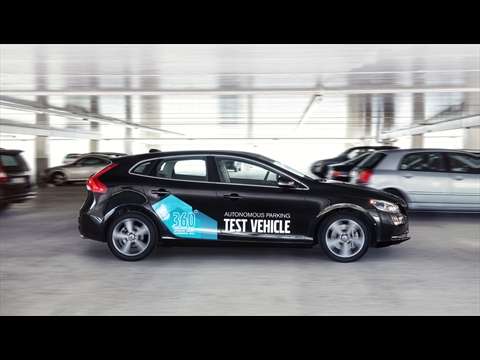(Phys.org) —Conversations about advancements in driverless cars on the road eventually have to pull over to discuss what happens when the cars need to be parked. Interactions with pedestrians and other moving objects are among the self-parking challenges confronting automobile R&D. Volvo is eager to ignite interest in its efforts thus far. They have developed the driverless car that, with the assistance of a smartphone, parks itself in a suitably vacant space. Here's their concept. The driver drops the vehicle off at a designated drop off zone at the parking lot. The driver uses a mobile phone application to activate "Autonomous Parking." Pressing a button on that mobile device institutes the command to the vehicle to go park itself; the driver walks away from the car. The vehicle deploys its sensors to navigate to a free parking space. The sensors and cameras scan for pedestrians and vehicles. Once a parking space is found, the vehicle parks there and automatically sends the driver notification that the Volvo has parked safely.
The procedure is then reversed. (When you need the vehicle you send a command to the phone that you want to pick the vehicle up. The vehicle proceeds to navigate itself through the parking lot to the designated area; you pick it up and drive off.)
Volvo said the system is such that existing parking lots could be used, so that investment costs in infrastructure would be lower.
Autonomous parking and platooning technologies are in development, said Volvo. But, as of now, Volvo is saying they are the first car manufacturer in the world, according to the video, to show a prototype of a self-parking car that interacts with other road users.
Volvo Car Group has developed an ingenious concept for autonomous parking. The concept car finds and parks in an open space by itself, without the driver inside.
Interestingly, MIT Technology Review in March this year took a look at self-parking cars and reported how Audi was running an experimental project in Germany which involved drivers who use a parking garage in Ingolstadt. The driver steps out of the car, and lets it drive into the garage to find a parking spot for itself. By pressing a button on a smartphone application, the car obeys in returning to the garage entrance. The garage, said the report, had laser systems that map the environment in 3-D, so that special cars with radar and wireless receivers could make their way through the garage while navigating past other cars, sense an open spot, pull in, and shut off the motor. The report said it would take more time to perfect and implement the technology.
"There are so many advantages to autonomous driving, said Toscan Bennett, Volvo vice president, product planning, "it is difficult to list them all." He said he would with safety, and, after that, environmental benefits.
Above all, auto manufacturers realize the attractive sales potential in being able to offer such a feature. As Bennett put it, "Who wouldn't want a car that drops you at your doorstep and then goes off and parks itself?"
More information: via Volvo
© 2013 Phys.org























